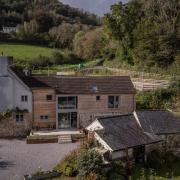A hundred years ago, a famous family created their holiday home at Kingswear. Coleton Fishacre is now in the care of the National Trust, but the D’Oyly Carte legacy is still felt in its historic garden, as head gardener James Grainger reveals
As Coleton Fishacre approaches its centenary, it feels appropriate to reflect on the changes that have occurred over the decades since the D’Oyly Carte family created the Arts and Crafts house and garden and how their legacy has influenced the way in which we look after this property today.
It was created as a holiday home to which the family could escape the demands and stresses of city life, relax with friends, and enjoy the tranquillity of the rural, coastal setting. It’s important for us to consider this historical context when managing the garden. We are conserving what once was a family home and our aim is to recreate that feel for those who visit today.

The D’Oyly Cartes gardened with a spirit of experimentation. They were keen to grow plants they had discovered during their various holidays abroad (often bringing back plant material with them) and that spirit of experimentation is an approach which we continue to this day. Looking back through the planting records we have a clear idea of the plants they valued, some of which they tried to grow and failed, some of which over time have been lost from the plant collection. It's within our gift to either reinstate those plants to the collection or to try and see if we can succeed where they once failed.
Ensuring that the garden continues to develop, and flourish, is our principal concern and there are many challenges which we must contend with. The impact of climate change is something we can’t shy away from and the effect it may have on the plants within our collection. This has been a big driver in forcing us to reassess our approach to managing the garden. It’s led us to become more sustainable, which we hope will ensure the long-term viability of the garden and that it serves to enhance nature and sit harmoniously within the wider landscape.

The Grade II*-listed garden contains a wonderfully diverse plant collection. The mild microclimate enables a wide variety of plants to be grown, many of which would be considered too tender to grow in other parts of the country. Any changes to the way in which we look after the collection must be sustainable to ensure that it continues to thrive. In the context of an historic garden, sustainability means that we are meeting its current needs, but also considering the long-term viability, and that any changes we implement, are positive and will future proof it for many years to come. In helping us achieve that, one of the most important changes we have implemented has been to manage the garden according to the principles of organic gardening.
As well as the detailed planting records, we are fortunate to have access to a collection of archive photographs. These give us a wonderful insight into how the garden was used. Images of the family lounging in deckchairs in the sunshine and playing badminton on the lawn, present an image of a relaxed idyll. Lawns awash with daisies and clover and paths littered with weeds are things that we have traditionally fought against in formal horticulture, but at Coleton Fishacre we have interpreted as guidance to adopt that same level of ‘relaxed management’ and we no longer use any pesticides or artificial fertilisers.

Water use is something that we are very mindful of, especially during recent periods of drought. Whilst we are fortunate to have a stream that naturally runs through the heart of the garden, we only water plants until they are established within a border, after that, they are on their own. By being careful about selecting the right plant for the right place, it should ensure that they thrive where planted. We never water lawns.
Oft overlooked, the most important thing to focus on in the garden is the soil. If you can provide the perfect growing conditions for your plants, then it will improve your chances of growing healthy plants with minimal intervention. Each year we add a surface mulch of our homemade compost to the formal herbaceous borders which improves its water and nutrient retentive capacity.

It's important to remember that any garden is primarily a habitat, home to a diverse range of flora and fauna. We are working hard to increase biodiversity within the garden and to create a balanced ecosystem. One of the principal ways we are doing this is being mindful of how much we interfere with nature. As gardeners we instinctively want to control and manipulate and make the garden work for us, but this can sometimes be detrimental to nature.
One example of how we have reversed this is in the formal Rill Garden where we deliberately leave the borders untidy over winter. This has three main benefits: Firstly, it provides a wonderful habitat for overwintering, beneficial insects such as ladybirds (which then help to manage the aphid population). Secondly, the dead plant material helps to provide an insulating blanket protecting the many tender perennials. Thirdly, it improves our efficiency as we cut back, prune and mulch at the same time in early spring.

Untidiness is one of the best things that can be done in a garden to improve biodiversity. This is slightly easier when you have a 24-acre site, compared with a small domestic garden. We create log piles in less formal areas of the garden and construct dead hedges using brash and woody material, which have the added benefit of providing interesting, semi-permanent architectural features which ultimately return the biomass into the soil as they slowly decompose.
We have also been experimenting with plant combinations. A recent installation has been the creation of a climate resilient border in an area of the garden that has a southerly aspect where the soil is free draining. Plants that grow in this space need to be adaptable to these harsh conditions.

In spring 2023 this border was replanted with a mixture of plants native to the Mediterranean, alongside a selection of plants endemic to the local coastline. Prior to planting, a surface mulch of eight tonnes of sharp sand was added. Principally, this was done to increase the challenging growing conditions, forcing the plants to set down deep roots, enabling access to available water and nutrients. The theory being that in the event of drought conditions, and having developed a robust network of roots, water lower down in the soil profile will help to sustain the plants. Had we mulched with compost and provided everything that the plants needed at surface level, they would have been more vulnerable during prolonged periods of dry weather.
The sandy mulch is particularly beneficial for solitary bees which like to nest in the ground in warm locations, and by including plenty of pollinator-friendly plants, it was an important consideration in this project.
This new style of approach to design and planting hopefully challenges people's perception of what we can do in our gardens and whether the success of a garden should be appraised by simply considering its aesthetic appeal, or as a more cohesive space where both plants and wildlife are thriving and supporting each other.
nationaltrust.org.uk
JAMES’ FAVOURITE FIVE

Aeonium ‘Zwartkop’
A wonderfully architectural shrubby perennial, with blackish-purple, succulent leaves. It’s a plant we use in containers because it doesn’t require regular watering. When sited in a sunny location and combined with the equally drought-tolerant, and contrastingly graceful, Erigeron karvinskianus, it makes a wonderful display providing several months of interest. It is quite tender, so will need bringing under cover for the winter months.

Prunus ‘Shogetsu’
The most beautiful ornamental cherry. I’m not normally a fan of double flowers, but I make an exception for this fine, small, deciduous tree. Pure white blossom emerges from pink buds at the beginning of April. It heralds the beginning of the growing season for us, and planted either side of a path, makes for a very photogenic location in spring. In autumn it has the added benefit of showing good leaf colour.

Geranium ‘Rozanne’
Sometimes you just need a good do-er, and this is the best. Tolerant of a range of situations, this herbaceous perennial will produce violet-blue flowers reliably throughout the growing season, above a clump of mid-green leaves. We use this in an area of the garden where many of the other plants have fleeting flowering seasons and this provides the longevity needed to carry everything through.

Allium schubertii
Alliums are a great way to incorporate additional drama into a border. We generally plant the bulbs underneath an herbaceous perennial, which in turn helps to conceal the dying foliage. This ornamental onion is particularly good as a cut flower, the large flower heads produce a dramatic, firework effect. At Coleton Fishacre, we harvest the flowers once they have gone over and dry them for use in displays over the festive period.

Myosotis sylvatica
My all-time favourite plant, the wood forgetme-not. In my eyes, it is the epitome of the perfect flower. When planted on mass, they create a carpet of rich blue which can be the perfect backdrop for spring tulips in contrasting colours of yellow or orange (Tulipa ‘West Point’ works well). Great for pollinators, allow it to self-seed around your garden.



























